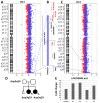Delineation of the Genetic Architecture and Clinical Polymorphism of 3q29 Duplication Syndrome: A Review of the Literature and a Report of Two Novel Patients With Single-Gene BDH1 Duplications
- PMID: 39739615
- PMCID: PMC11686339
- DOI: 10.1002/mgg3.70047
Delineation of the Genetic Architecture and Clinical Polymorphism of 3q29 Duplication Syndrome: A Review of the Literature and a Report of Two Novel Patients With Single-Gene BDH1 Duplications
Abstract
Background: Chromosome 3q29 duplication syndrome is a rare chromosomal disorder with a frequency of 1:5000 in patients with a neurodevelopmental phenotype. The syndrome is characterized by phenotypic polymorphism and reduced penetrance.
Methods: Patients were investigated by performing a cytogenetic analysis of GTG-banded metaphases, aCGH with the SurePrint G3 Human CGH Microarray 8×60K, qPCR, FISH, and WES.
Results: Here, we report five new patients with atypical duplications overlapping with the 3q29 duplication syndrome region and no other genetic findings. In two patients, duplications were found in the single BDH1 gene, a candidate gene for the 3q29 duplication phenotype. For the first time, we delineated and described the smallest minimal critical region, including the single BDH1 gene; in our patients, this region was associated with ASD, heart defects, biliary tract dysfunction, and obesity. The frequencies of the pathological phenotypes in duplication carriers reported in the literature were calculated and compared with those in patients with 3q29 deletions. Most of the phenotypes were observed in both groups but were significantly less common among individuals with 3q29 duplications. Mirrored phenotypes in patients with duplications and deletions included overweight and weight deficit. Schizophrenia, generalized anxiety disorder, and recurrent ear infections were unique phenotypes of patients carrying deletions.
Conclusion: Chromosome 3q29 duplication syndrome is characterized by a complex genetic architecture and clinical polymorphism.
Keywords: BDH1; 3q29 deletion syndrome; 3q29 duplication syndrome; minimal critical region; mirrored phenotypes; unique phenotypes.
© 2024 The Author(s). Molecular Genetics & Genomic Medicine published by Wiley Periodicals LLC.
Conflict of interest statement
The authors declare no conflicts of interest.
Figures





Similar articles
-
3q29 microduplication syndrome: Description of two new cases and delineation of the minimal critical region.Eur J Med Genet. 2018 Aug;61(8):428-433. doi: 10.1016/j.ejmg.2018.02.011. Epub 2018 Mar 1. Eur J Med Genet. 2018. PMID: 29501613
-
3q29 duplications: A cohort of 46 patients and a literature review.Am J Med Genet A. 2024 Jul;194(7):e63531. doi: 10.1002/ajmg.a.63531. Epub 2024 Feb 29. Am J Med Genet A. 2024. PMID: 38421086 Review.
-
3q29 microduplication syndrome: New evidence for the refinement of the critical region.Mol Genet Genomic Med. 2023 Apr;11(4):e2130. doi: 10.1002/mgg3.2130. Epub 2023 Jan 24. Mol Genet Genomic Med. 2023. PMID: 36691815 Free PMC article.
-
3q29 microduplication syndrome: Clinical and molecular description of eleven new cases.Eur J Med Genet. 2020 Dec;63(12):104083. doi: 10.1016/j.ejmg.2020.104083. Epub 2020 Oct 9. Eur J Med Genet. 2020. PMID: 33039685 Review.
-
New phenotypes associated with 3q29 duplication syndrome: Results from the 3q29 registry.Am J Med Genet A. 2020 May;182(5):1152-1166. doi: 10.1002/ajmg.a.61540. Epub 2020 Mar 10. Am J Med Genet A. 2020. PMID: 32154651 Free PMC article.
References
Publication types
MeSH terms
Substances
Grants and funding
LinkOut - more resources
Full Text Sources
Molecular Biology Databases

